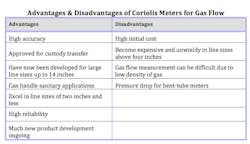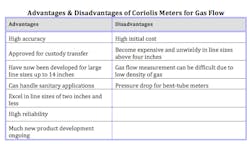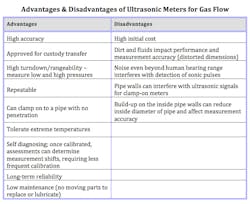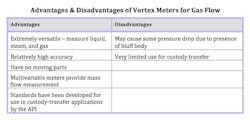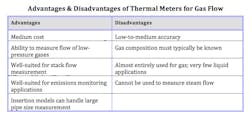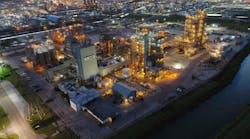Will there ever be a perfect type of flowmeter? Such a flowmeter would measure with high accuracy in any application, would be extremely reliable, have high turndown, little-to-no maintenance, and would require little-or-no calibration. It would also have to be relatively inexpensive, both in terms of purchase price and lifecycle costs.
While some suppliers might argue that they produce a nearly perfect flowmeter, it is unlikely that anyone will ever produce a perfect meter. The reason is that every type of flowmeter has its own advantages and disadvantages and, due to its technology or principle of operation, is going to be more suitable for some applications and not suitable for others.
Some disadvantages of different flowmeter types stem from the technology, while others have more to do with application, installation, or material of construction. For example, turbine meters by their very concept of operation have moving parts, and even though suppliers have taken steps to make them more reliable, it is not possible to imagine a turbine meter without moving parts. Coriolis meters, by contrast, do not have any internal moving parts, but their technology requires that they become quite large and also expensive in line sizes above four inches. Magnetic flowmeters cannot currently measure hydrocarbon liquids because they require a conductive fluid to make the measurement.
When it comes to gas flow measurement, it is instructive to look at the advantages and disadvantages of different types of flowmeters. Gas flow is in many ways more difficult to measure than liquid flow, although some would argue that steam flow is the most difficult measurement. There are some excellent flowmeters for measuring gas flow, but each type has its advantages and disadvantages. This article explores the advantages and disadvantages of different types of new-technology flowmeters for measuring gas flow. We will cover the pros and cons of some of the more traditional-technology flowmeters in the September issue of Flow Control.
RELATED: Pros & Cons of Traditional Technology Flowmeters for Gas Flow
Coriolis Flowmeters for Gas Measurement
Coriolis flowmeters have been one of the fastest-growing flowmeter types over the past five years. In many process plants, users are selecting them to replace differential-pressure (DP) meters. Despite their higher initial purchase price, many users find them a good investment when cost of ownership is considered.
Coriolis flowmeters are used to measure gas flows, but they have some limitations. Coriolis meters have an easier time measuring liquids than gases, because liquids are denser than gases. Traditionally, Coriolis flowmeters have been expensive and unwieldy in line sizes above four inches. However, in the past several years, a number of suppliers have begun producing Coriolis flowmeters in line sizes above six inches. These include Endress+Hauser, which in May 2011 introduced a 14-inch Coriolis meter for gas and liquids; Micro Motion; and KROHNE. Rheonik (now part of GE Measurement & Control Solutions) used to be the only supplier in the large-line Coriolis market. As a result of this influx of manufacturing capability in the large-line segment, Coriolis flowmeters may begin gaining wider acceptance in larger line applications.
One of the most important features of Coriolis flowmeters is that they measure mass flow directly, meaning the mass flow value is not computed using a formula. Most other flowmeters, except for thermal meters, measure volumetric flow. One way to measure volumetric flow is by collecting the fluid into small compartments and counting how many times the compartments are filled. This is how positive-displacement meters work, and it resembles the process of pouring milk from a large container into individual cups and counting the cups.
Accuracy and reliability are the top two drivers of the flowmeter market. This has been demonstrated in a number of different surveys of flowmeter users conducted over the past eight years. Coriolis flowmeters rate very high on both counts. Not only are Coriolis flowmeters the most accurate meter, they also require very little maintenance. With no internal moving parts, Coriolis meters require a minimum amount of attention once they are installed. With no moving parts to wear out or degrade, they are a very reliable meter.
Ultrasonic Flowmeters for Gas Measurement
There are two main types of ultrasonic flowmeters–transit-time and Doppler. A transit-time ultrasonic flowmeter has both a sender and a receiver. It sends two ultrasonic signals across a pipe at an angle: one with the flow, and one against the flow. The meter then measures the “transit time” of each signal. When the ultrasonic signal travels with the flow, it travels faster than when it travels against the flow. The difference between the two transit times is proportional to flowrate.
Many technological improvements have been made in ultrasonic flowmeters over the past 20 years. Because of improvements in electronic processing technology, transit-time meters are better able to handle fluids that are not completely clean. These improvements have also increased the accuracy of ultrasonic meters, which has led to broader use of these meters in a wider variety of conditions.
Another important technological improvement has been the development of multipath transit-time flowmeters, which use more than one ultrasonic signal or “path” in calculating flowrate. Each path requires a pair of sending and receiving transducers. By using more than one path, the flowmeter measures flow at more than one location in the flowstream, leading to greater accuracy.
Ultrasonic flowmeters have a distinct advantage over each of the other newtechnology meters. Unlike Coriolis meters, ultrasonic flowmeters do very well in large pipe sizes. Over 80 percent of the Coriolis meters are sold for pipe sizes of two inches or less. While some Coriolis meters have successfully been used in four-inch and six-inch lines, they become unwieldy and quite expensive in sizes over four inches. Size can actually be an advantagefor ultrasonic flowmeters, since larger pipes have more room for the ultrasonic signal to cross. For pipes six inches and larger, ultrasonic flowmeters are in most cases a better choice than Coriolis meters, especially for gas flow. The largest line size available for Coriolis meters is 14 inches.
Ultrasonic flowmeters have an advantage over magnetic flowmeters in that they can be used to measure the flow of nonconductive liquids, gases, and steam. Magnetic flowmeters have very limited use in the oil & gas production, transportation and refining industries because petroleum-based liquids are nonconductive. For the most part, magnetic flowmeters simply cannot be used to meter hydraulic fluids, oil, or natural, process, or flare gas. They cannot be used to measure the flow of steam. This is one of the most important reasons why the ultrasonic flowmeter market is growing so much faster than the magnetic flowmeter market. Magnetic flowmeters are simply unable to participate in the fast-growing oil and gas flow measurement markets.
Vortex Flowmeters for Gas Measurement
While vortex flowmeters were first introduced into industrial markets in the early 1970s, their history goes back farther than that. Vortex flowmeters make use of a physical principle involving the formation of vortex swirls (vortices) downstream of an obstruction placed in a flowing stream. Leonardo da Vinci first described this phenomenon around 1500. In 1911, Theodore von Karman did an analysis of the double row of alternating vortices that form when a flat object is placed in the path of flow. This phenomenon is now called von Karman’s vortex street.
Vortex flowmeters make use of the effect studied by von Karman. They have a bluff body as a component, inserted in the flowstream. A bluff body is an obstruction with a broad, flat front. In a vortex meter, the bluff body is mounted at right angles to the flowstream. As the fluid impacts the bluff body, a series of alternating vortices is generated.
Flow velocity is proportional to the frequency of the vortices. The vortex flowmeter determines vortex frequency by using one of several types of sensors, including pressure, thermal, and ultrasonic. Flowrate is calculated by multiplying the area of the pipe times the velocity of the flow.
In January 2007, an American Petroleum Institute (API) committee approved a draft standard for the use of vortex flowmeters for custody transfer of liquid and gas. The standard was updated in 2010. This approval is likely to boost sales of vortex meters over time, as suppliers develop products that conform to the standard. So far, however, vortex meters have not been able to penetrate the market for custody transfer of natural gas, which is still dominated by ultrasonic, DP, and turbine meters.
The chief advantage of vortex flowmeters is their versatility. They can reliably measure the flow of gas, liquid and steam, and can tolerate the high temperatures associated with steam flow measurement. DP flowmeters using orifice plates are the only other flowmeter type with this versatility.
But vortex meters measure fluids typically with greater accuracy and also with less pressure drop than DP flowmeters. Both vortex and DP flowmeters have benefited from the development of multivariable transmitters that measure mass flow.
Thermal Flowmeters for Gas Measurement
Both thermal and Coriolis flowmeters measure mass flow. However, thermal meters measure mass flow quite differently than Coriolis meters. Instead of using fluid momentum, as do Coriolis meters, thermal flowmeters make use of the thermal or heat-conducting properties of fluids to determine mass flow. While most thermal flowmeters are used to measure gas flow, some also measure liquid flow.
Hot-wire anemometers consist of a heated, thin-wire element, and are very small and fragile. Hot-wire anemometers were used in velocity profile and turbulence research. Because they are susceptible to breakage and to dirt, they are not suited to industrial environments. Industrial thermal flowmeters use a similar concept of measuring the speed of heat dissipation to determine mass flow, but use more rugged sensors that are better adapted to industrial environments.
There are several different thermal flowmeter technologies. Some measure the speed with which heat that is added to the flowstream disperses. Others measure the temperature difference between a heated sensor and the ambient flowstream. Thermal flowmeters typically require one or more temperature sensors to measure the fluid temperature at specific points.
Thermal flowmeters have several main advantages. One is a relatively low purchase price. Second, thermal flowmeters can measure the flow of some low-pressure gases that are not dense enough for Coriolis meters to measure. Both of these advantages give thermal flowmeters their own unique niche in gas flow measurement.
The main disadvantage of thermal flowmeters is low-to-medium accuracy, although suppliers have improved the accuracy of thermal flowmeters in recent years. While some thermal flowmeters may achieve accuracy levels of 1 percent, other thermal flowmeters have accuracies in the 3-5-percent range. Users who are considering thermal flowmeters need to balance their accuracy needs with their cost requirements.
Where We’re Heading
One of the most dramatic developments in the past several years in the newtechnology flowmeter market has been the introduction of Coriolis flowmeters with large line sizes. Micro Motion’s Coriolis flowmeters can be used in line sizes of up to 12 inches, while Endress+Hauser has recently introduced a Coriolis for line sizes of 14 inches. Endress+Hauser’s Coriolis flowmeter uses four tubes to achieve a highly accurate measurement. Elster has also released a new six-path ultrasonic
flowmeter for custody transfer of natural gas. All of these flowmeters are aimed primarily at the custody-transfer market. In fact, it is the requirements for custody transfer that are driving much of the new product development in Coriolis and ultrasonic flowmeters.
Also, flowmeters are becoming more modular. For example, Micro Motion has developed a core processor that provides greater installation flexibility and enhanced computing power. The core processor digitally processes raw signals from the sensor. Modularity allows greater processing power to be concentrated in a single device.
Jesse Yoder, Ph.D., is president of Flow Research Inc. in Wakefield, Mass., a company he founded in 1998. He has 24 years of experience as an analyst and writer in process control. Dr. Yoder specializes in flowmeters and other field devices, including pressure and temperature products. He has written over 150 journal articles on instrumentation topics. Dr. Yoder can be reached at [email protected].www.flowresearch.com
For more information on Flow Research’s analysis in the area of gas flow measurement, see www.gasflows.com.
